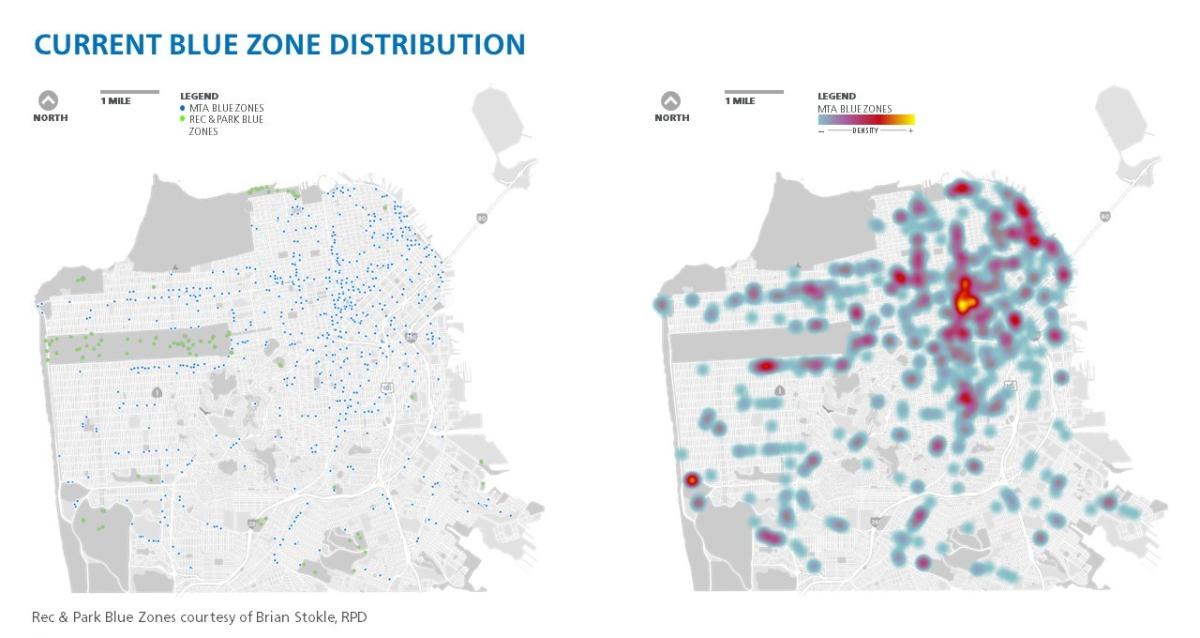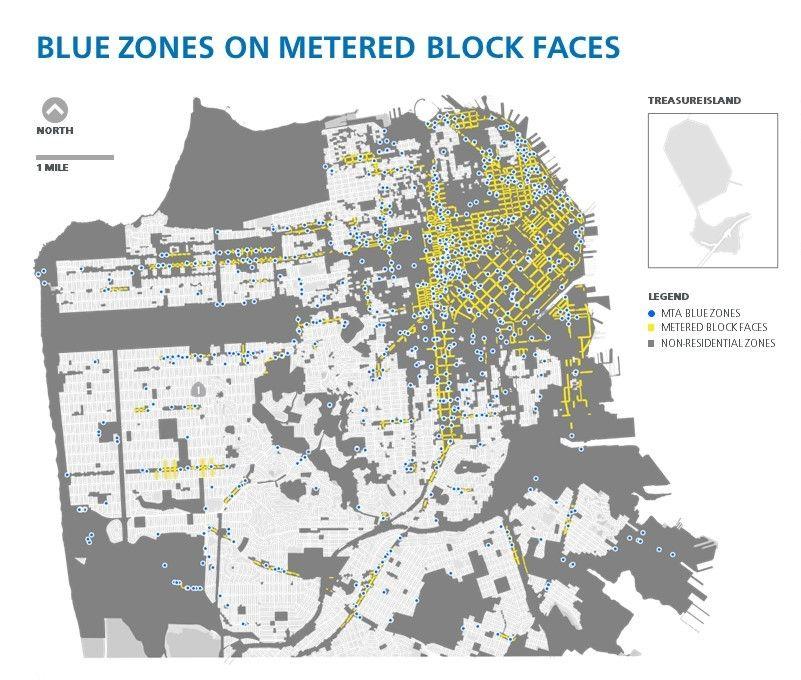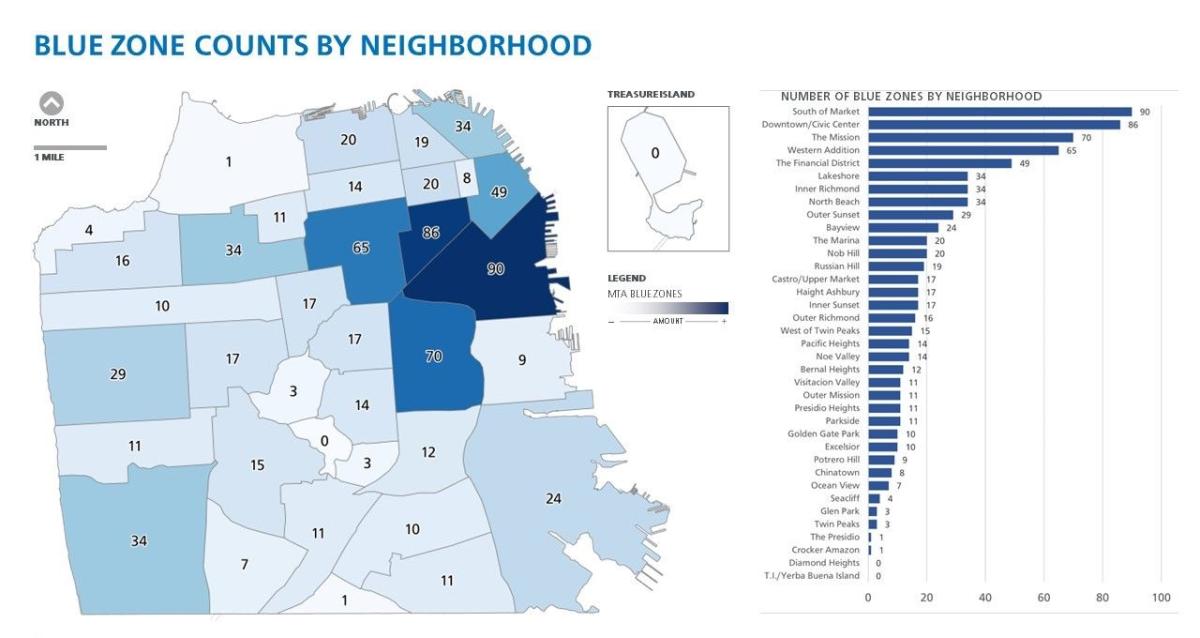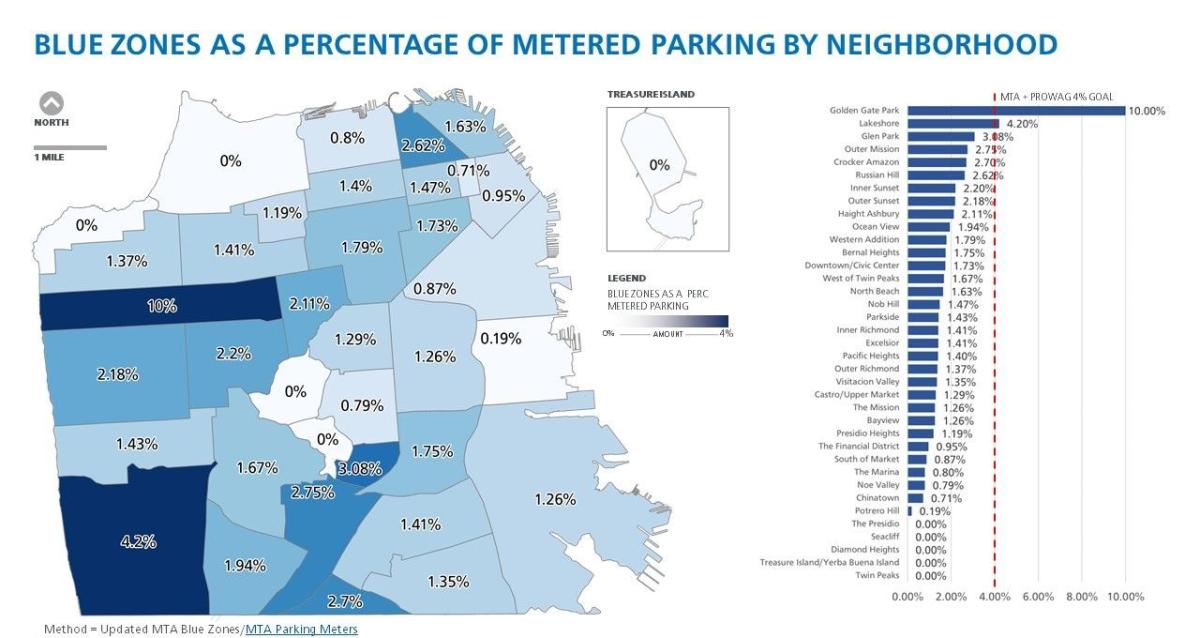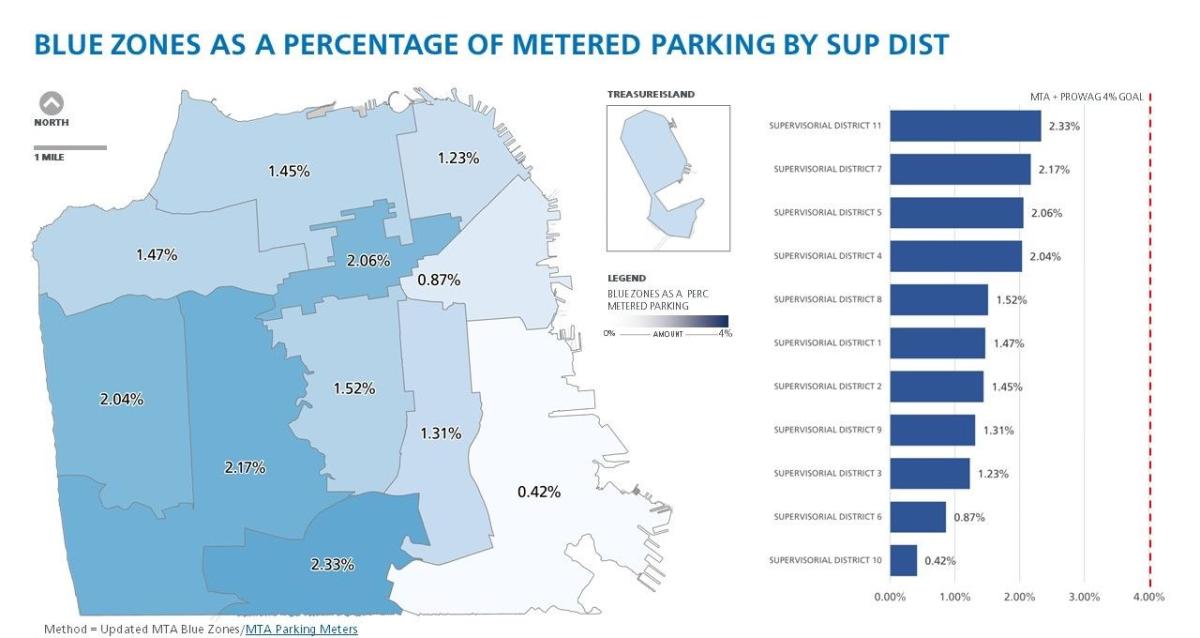Key Takeaway: The number of accessible parking spots should be increased to better meet community need and mitigate the effects of disabled parking placard abuse.
About Blue Zones and Accessible Passenger Loading Zones
In San Francisco, accessible parking spaces are known as "blue zones" due to the blue paint the SFMTA uses to mark them. Blue zones are street parking spaces that can only be used by people with a California Disabled Person Parking Placard.
Blue zones are usually located:
- Next to a curb ramp for easier access to the sidewalk.
- In dense commercial areas.
- Near the entrance of public facilities like libraries, public parks and playgrounds.
- Near destinations that serve many people .
In addition to accessible parking spaces, the SFMTA also prioritizes installing accessible passenger loading zones with curb ramp access, which make Paratransit and private vehicle drop-off and pick-up easier for people with disabilities.
The SFMTA maintains and publishes a map of existing blue zone locations, available on the SFMTA website.
2024 Blue Zone Analysis
In 2023, Staff in Accessible Services launched a project to better understand the existing distribution of blue zones in the city.
As part of this project almost 1,000 blue zone data entries were updated, cross-referenced and verified using Google Streetview to create an accurate database of blue zone locations. Once updated, analyses were performed to understand where accessible parking spaces are currently located in the city and where new spaces could be installed to meet new and existing goals for accessible parking minimums in the city.
According to internal agency goals and new federal regulations outlined in the Public Right-of-Way Accessibility Guidelines (PROWAG), the SFMTA aims to have a ratio of 4% blue zones to metered parking spaces across the city. At the time of the report, there was a ratio of 2.13% blue zones to metered parking citywide.
Analysis of the updated blue zone data indicates two neighborhoods, Golden Gate Park and Lakeshore, currently meet the intended ratio of 4% blue zones to metered parking spaces. This is likely due to the fact that these areas have a relatively low proportion of parking meters for the size of the area. In many viable areas of the city, blue zone counts need to double to meet statutory targets.
Figure 1. Current Blue Zone Distribution. Note: Rec & Park Blue Zones are not Administered by the SFMTA
Figure 2. Blue Zones on Metered Block Faces
Figure 3. Blue Zone Counts By Neighborhood
Figure 4. Blue Zone Counts by Supervisor District
Figure 5. Blue Zones as a Percentage of Metered Parking by Neighborhood
Figure 6. Blue Zones as a Percentage of Metered Parking by Supervisor District
Requesting Blue Zones
The SFMTA’s Parking and Curb Management team is responsible for accessible parking, which allows San Francisco residents to request the installation of accessible parking at key locations.
Businesses, institutions and residents can request individual blue zones at locations that serve many users throughout the day. They may request them through an online application through the Color Curb Program. Neighborhood groups may also request a corridor-wide increase in blue zones through our Taxis, Access, and Mobility Services team.
After a blue zone request is made, the SFMTA’s Parking and Curb Management team evaluates the site for feasibility and determines whether it meets the SFMTA’s blue zone standards. These standards are guided by SFMTA policy and the U.S. Access Board’s Public Right of Way Accessibility Guidelines, known as PROWAG. PROWAG requires that blue zones compose at least 4% of metered parking spaces on any given block perimeter[1], complimenting the SFMTA’s broader goal to have blue zones make up at least 4% of metered curb parking spaces citywide. As of November 2023, there are an estimated 26,500 metered parking spaces in the city. This includes an estimated 840 blue zones, equivalent to 3.17% of all metered parking spaces in the city.
Accessible Parking Fraud
The California Department of Motor Vehicles recognizes that fraudulent use of disabled parking placards make it harder for people with disabilities to find open blue zone parking spaces. Some people will misuse placards issued to family or friends to avoid paying parking fees or for convenience.
In October 2012 the SFMTA and the Mayor’s Office on Disability formed the Accessible Parking Policy Advisory Committee, a stakeholder group comprised mostly of disability rights advocates, to develop a package of policy recommendations aimed at increasing access to street parking and reducing disabled parking placard misuse. The committee put forth the following policy recommendations:
- Increase the number of blue zones.
- Improve enforcement of placard misuse.
- Increase oversight of placard approvals.
- Allow jurisdictions to remove the meter payment exemption.
- Direct an equivalent amount of revenue to accessibility improvements.
- Allow jurisdictions to establish reasonable parking time limits.
The SFMTA has taken steps towards implementing the recommendations that are under local control, including increasing the number of blue zones and improving disabled parking placard misuse enforcement. Other recommendations require changes at the state level. These include improving the DMV’s oversight of placard approvals and allowing qualified jurisdictions the option of requiring meter payment and four-hour time limits for placard holders.
Advancing the Accessible Parking at the SFMTA
After performing the analysis of blue zone data and locations in 2023 and 2024, staff at the SFMTA developed recommendations for the improvement of accessible parking in the city. These include:
- Keep blue zone data current and up to date.
- Establish a blue zone working group within the agency to proactively add more blue zones to the city's streets.
- Make the online map of blue zones more useful and if possible, making blue zone locations available in apps like Google Maps.
- Learn more about the customer's experience trying to find and use accessible parking in the city.
- Evaluate the Agency's blue zone siting methodology and policy and update according to identified needs.
- Create more specific rules for the design and location of blue zones that go beyond the general guidance in PROWAG.
- Create a public timeline for adding more blue zones to reach the 4% target.
- Increase awareness of the importance of blue zones as a form of transportation infrastructure for older adults and people with disabilities.
- Form a city-wide accessible parking council to coordinate best practices and locations of accessible parking among various city departments and jurisdictions.
[1] Public Right-of-Way Accessibility Guidelines, Table R211 On-Street Parking Spaces. https://www.access-board.gov/prowag/scoping.html#table-r211-on-street-parking-spaces-1.
